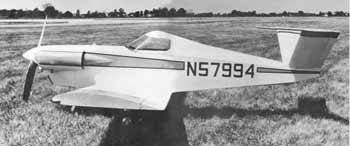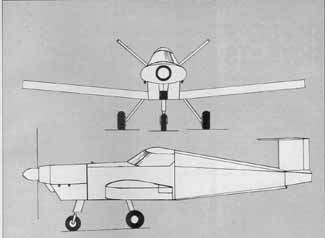Davis DA-5A: The
Ultimate Commuter Plane? |
PAGE THREE
I flew a series of climbs at different airspeeds trying to determine what its best rate of climb was. The first speed I latched onto was 100 mph which gave a solid 700 fpm, very respectable for only 65 hp in that heat. I dropped the speed in 5 mph increments and soon found myself getting 1100 fpm at 85 mph with plenty still in the bank. Going the other direction, with power completely off, 85 mph gave a timed rate of descent of around 1300 fpm and a moderate glide angle. It fell right in there with a Cherokee in the approach configuration. It obviously didn't really need flaps to steepen the glide angle. The last thing I did before taking it back to the barn was to find three distinctly marked section lines (for you city types, a section is a mile long) and came down to 1500 feet to run two-way speed checks on them: I got exactly the same times going both ways which indicated either no wind or a 90 degree crosswind. I fiddled with my computer and came up with an amazing 144 mph. I didn't believe it, so I did it again—twice. All three runs came up between 142 and 144 mph in fairly turbulent air. Now that's what I call truckin'. especially at 4 gallons per hour. That means the DA-5A has all absolute range of about 600 miles on its 17 gallons. Since it's a dirt simple airplane, all that's needed before aiming down final is looking for traffic and getting the carb heat. On final, the Cherokee-like sink rate made for a Cherokee-type pattern ...short and with a bit of power. There were a few humps in the air and the Davis chopped right through them with a poke or two on the stick keeping things square with the world. At 85 mph there's plenty of flare, although the DA-5A is small enough and low enough that ground effect really makes those squared off wings work and there's a slight tendency to balloon. Hold it off, hold it! Chunk! And the nearly rigid gear dropped onto the runway for an absolutely boring roll-out. The Davis DA-5A is an airplane that will, or at least should, be immensely popular in the future. As fuel prices start to climb to $2 a gallon (Ed Note from 2007: that really sucks, doesn’t it?) and engine prices continue going right out of sight, we're all going to look for alternatives. That's the coming thrust in homebuilt aircraft...getting the most speed with the smallest engine. The engine will be the deciding factor. There are lots of aircraft on the horizon that look very promising from the performance/economy standpoint: for example Rutan's VariEze and Molt Taylor's Imp (the BD-5 has been on the horizon so long we're beginning to think it's a mirage). But these airplanes depend upon brand new construction techniques, engines that haven't really proven themselves in the air or configurations that somehow just don't go down right with the traditionalists. That's where the Davis will make its mark—with the traditionalists. Other than its butterfly tail, there's nothing at all exotic about the Davis DA-5A. In its backwards sort of way. it's a more comfortable airplane for many to be around because it doesn't present anything that's out of the ordinary or that hints of any kind of experimentation. It seems like a sure thing. And the beat goes on—the more adventurous among us will be whittling foam or worrying about pusher prop efficiency and others will be listening to their engine's beat with stethoscopic ears. In the meantime, Leeon Davis and his son Harold, will be enjoying their air. plane. They have peace of mind. That might be because that's just the way they are, or it might be because they know in their airplane everything works. They can count on having a lot of the old line conservatives, the middle mass of American aviation, following them. They look as if they've found an answer to the key question: How can I fly fast and cheap? Build a Davis! BD
SPECIFICATIONS
|


